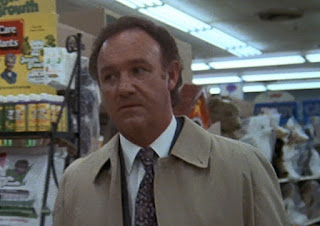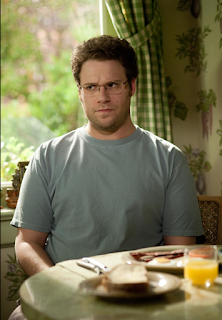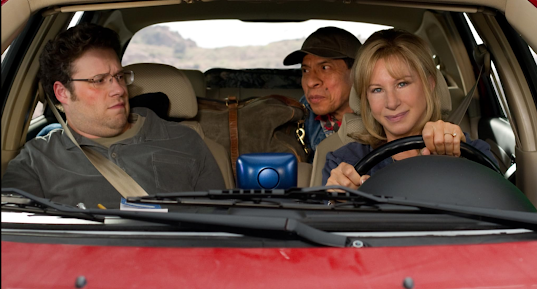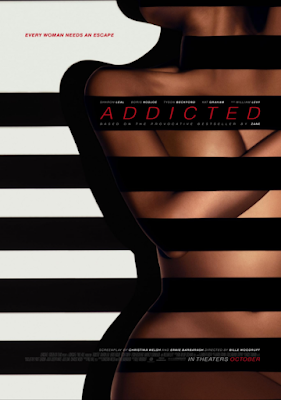Sunday, August 11, 2024
Saturday, March 2, 2024
Short Takes: ‘Addicted’ (2014) ★★
And lead character, Zoe Reynard (Sharon Leal) is all about the dick, though, as she explains to her therapist Dr. Marcella (Tasha Smith, acting like an Oprah-bot), she has a very fulfilling life, with a loving (and very hot!) husband, two beautiful children, and she owns her own successful business merchandising artworks of up-and-coming artists. Plus, all her employees love her! Her assistant Shane complements Zoe’s fashion sense the moment she walks in the door, and her best friend/…um, I’m going to say vice president, Brina (Emayatzy Corinealdi), is so devoted to her job that she dismisses the very idea of Zoe paying her more to do it. There’s no sex and I’m already getting a semi just thinking about this woman’s life.
But Addicted wastes little time getting to the sex, showing Zoe and that hunky husband of hers, Jason (Boris Kodjoe), enjoying some hot R-rated boning less than 10 minutes in. After they come, Zoe reaches beneath the sheet for Jason’s sticky dong, asking if he’s ready for round three(!), only to be disappointed when Jason drifts off to sleep. (Lady, give him a chance to recuperate from round two; you two aren’t 18 anymore.) Then, just like that, Zoe deems her sex life boring and goes to her home office to get off to Internet porn, which she evidently does frequently as she keeps a vibrator in a desk drawer. Lord help her if her children or her mother—who lives with them to take care of the kids and give her daughter “hmm-hmm” looks—go hunting for a pen.
That all changes when she meets famed (but, implausibly, never photographed) artist Quinton Canosa (William Levy) at Atlanta’s High Museum. Quinton understandably sets her girlie parts a-tingle, so it’s no surprise that she readily fucks him. Well, “readily” might be overstating it, as Zoe does try to push Quinton away, telling him that what they’re doing is not right, a protest he quickly silences by going down on her.
But Quinton is not enough. Zoe hits the clubs, hooking up with the dangerously sexy Corey (hey, it’s Tyson Beckford from Chocolate City) in a suspiciously vacant (and clean) restroom and sneaking out to join him at artfully lit sex parties. Zoe is so hooked on cock that she begins to neglect her family and her business. She knows she needs to quit both these guys, but she’s too busy getting rocks off to worry about hitting rock bottom.
Though it’s not the trash treasure I hoped for, I kind of enjoyed this one. The acting is fair, though Levy often comes off as smarmy rather than seductive. Director Bille Woodruff at least knows his audience, meaning Leal’s body is decoratively covered while her male co-stars’ are frequently exposed (no full frontal, but a fair amount of man-ass). As an Atlanta resident I had some fun spotting familiar locations on screen (I loved that the now-shuttered Radial Café, very much a casual dining spot in its day, is presented as a restaurant so exclusive it requires strict punctuality for reservations). What stops the movie from being satisfying trash is its uneven Lifetime-y script. Sometimes it’s the fun type of Lifetime movie, but too often it’s just bland, and its portrayal of sex addiction way too sanitized. There’s sex addiction, where otherwise respectable people pull trains with hobos on their lunch hour and sneak off after putting the kids to bed to go writhe naked in urinal troughs, and then there’s “sex addiction,” an affliction (primarily male) celebrities diagnose themselves with when they’ve been caught cheating (or worse). Zoe’s problem falls squarely in the second category, and no amount of last-minute daytime TV psychodrivel can convince the audience otherwise.
Saturday, February 17, 2024
The Bombs of Barbra
Among the many problems critics cited with the 1976 remake of A Star is Born—and they cited a bunch of them at the time—was the preposterousness of Barbra Streisand’s Lite FM pop winning over hard rock audience (mitigating factor: the rocker in question was played by country singer Kris Kristofferson, R.I.P.). To Barbra’s fans, however, this makes perfect sense. How could anyone not be won over by one of the most talented women of our time? Her fans were sold—I certainly was—and so A Star is Born became another one of Barbra’s many hit films and another fuck you to her critics.
But Barbra’s fans didn’t line up for everything she did. Though most of Barbra’s films were successful—her track record is pretty impressive—she did have a few bombs. So, while Barbra’s successes are being celebrated in the wake of her recently published door stopper of a memoir My Name is Barbra (also a hit), I thought I’d revisit her few failures, which is far easier—and faster—than reviewing that autobiography. (Nine-hundred and ninety-two pages? Oh, fuck no.)
I’m going to bypass Hello, Dolly!, which, similar to Cleopatra, was both a box office hit (No. 5 on the list of top grossing movies for 1969) and a financial disappointment (i.e., it cost too goddamn much to make), though 20th Century Fox, as it did with Cleopatra, eventually recouped its investment. Instead, I’m jumping to Barbra’s first real flop, UP THE SANDBOX.
 |
| Margaret joins the other moms in Central Park. |
Up the Sandbox just might be the closest Barbra ever got to making a small arthouse film. In this 1972 adaptation of Anne Roiphe’s 1970 novel, Barbra plays Margaret, a young New York housewife, married to a college professor (David Selby) who regularly escapes her stifling existence through vivid fantasies. Sometimes the fantasies are dark (joining a group of activists to blow up the Statue of Liberty), but most are played for laughs (Margaret pushing her nagging mother’s face into a birthday cake; increasing her breast size at will during a college faculty party).
 |
| Margaret's mother (Jane Hoffman) fights back. |
 |
| Fidel Castro (Jocobo Morales) has a secret. |
 |
| Margaret prepares to blow up the Statue of Liberty, a scene Barbra says likely would not be included were the film made today. |
 |
| Margaret journeys to Africa with musicologist Dr. Beineke (Paul Benedict), but the natives are less than welcoming. |
Too bad not a whole lot of people saw it. Reportedly audiences at the time were put off by how the fantasies were introduced. Instead of doing the standard harps and swirling dissolves to announce fantasy sequences, Kershner lets them happen organically, as if they are part of Margaret’s reality. It’s usually pretty easy to tell when a scene has segued into fantasy, but apparently this confused 1972 audiences, which hurt word of mouth. (Christopher Nolan would have had a very different career trajectory if he started making films in the early 1970s.)
 |
| Paul (David Selby) and Margaret get real. |
Did it deserve to bomb? No. It’s definitely worth seeking out if you’re a Streisand fan. Even if you’re not, you might still want to check it out as it’s not a typical Streisand film. It’s available for streaming. Those who prefer physical media will have to be content with a DVD, but if you go that route avoid Barbra’s commentary track, which adds little beyond proving she’s as self-absorbed as her detractors say she is.
‘A Little, European Kind of Film’
If there was any justice in the world, the next movie on this list would be 1979’s The Main Event, which I think is Barbra’s worst movie (for her co-star, the late Ryan O’Neal, worst was yet to come), but, no, The Main Event made money. Instead, Barbra’s second bomb detonated in 1981 with the release of the non-com ALL NIGHT LONG.
 |
| George Dupler (Gene Hackman) and Cheryl (you know who) enjoy dinner at sunset. |
All Night Long was originally meant to be a modest little comedy about George Dupler, a middle-aged exec for a drugstore chain who, after reacting violently to being passed over for a promotion, gets demoted to night manager of one of the company’s 24-hour stores. George then begins having an affair with Cheryl, the wife of his fourth cousin, who is also having an affair with George’s son Freddie (Cheryl, not George’s fourth cousin). Gene Hackman (R.I.P.) was cast as George, and Lisa Eichorn as Cheryl. It was the American debut of Belgian director Jean-Claude Tramont.
 |
| Gene Hackman wonders what the fuck happened to his movie. |
Unfortunately for the movie, Tramont was married to ’70s superagent Sue Mengers. Mengers represented Hackman, but her biggest client was Barbra Streisand. Mengers had wanted Barbra in the role of Cheryl from the beginning, but Barbra, then busily trying to get Yentl off the ground, passed. This didn’t stop Mengers, who began badmouthing Eichorn’s performance the moment she saw the early rushes (other people connected to the film said Eichorn was fine). Mengers’ behind the scenes fuckery is detailed fully in Brian Kellow’s biography of Mengers, Can I Go Now? (or you could just read an excerpt here), but the TL;DR version is that Mengers got Barbra to reconsider with a very persuasive $4 million payday, got Eichorn fired, and transformed her husband’s low-stakes project into A Barbra Streisand Film.
beat out by Barbra. However, the one source I found that even mentions
Anderson in connection with this movie reports she was considered after
Barbra initially turned the part down, meaning she lost the role to Lisa Eichorn.
Either way, she dodged a bullet (only to catch a much bigger bullet).
 |
| The 2004 DVD cover is closer to the tone of the movie, but still misses the mark. Also, did they give Barbra a Photoshop nose job? |
All Night Long is not a rollicking sex farce. It’s not that fun, or that funny. “It was really a little, European kind of film,” is how Barbra described it in Can I Go Now? She said she “felt totally betrayed” by the movie’s misleading ad campaign. Audiences also felt betrayed, and the movie quickly sank at the box office, making just under $4.5 million against its $15 million budget.
 |
| Dennis Quaid might actually be stoned in this scene. |
All Night Long isn’t that funny, but it isn’t unwatchable, either. I’d describe it as a neutered Middle-Age Crazy or a second-rate Starting Over. It’s a direct-to-video movie before those were a thing. Barbra, wearing a Rona Barrett wig and push-up bras, manages to pull off the role of ditzy suburban cougar Cheryl, and it’s fun to see her play against type. Unfortunately, Cheryl isn’t a character so much as she is a collection of quirky behaviors: she rides a scooter; she has a love of the color lavender so obsessive that even her cigarettes are that color; she meticulously picks the raisins out of a cinnamon raisin Danish because she read somewhere you shouldn’t eat fruit and carbs together. In fact, most of the laughs Cheryl gets hinge on the fact that she’s played by Barbra Streisand, such as a scene in which Cheryl, composing a country song on an electric organ, proves to be a lousy singer, which got the movie’s biggest laugh when I saw it in the theater (I’m old, y’all!) Would this scene have worked if Lisa Eichorn was in the role of Cheryl? Probably, but the laughs likely wouldn’t have been as loud.
But most of the characters in All Night Long are underwritten, with only Hackman’s George getting fleshed out to any degree. In fact, the whole movie plays out like they were working from screenwriter W.D. Richter’s first draft. In addition to underdeveloped characters, there’s a satirical undercurrent about suburban malaise and the so-called American Dream that’s never fully realized, either because Richter’s script never quite articulated it or Tramont never quite grasped it. In the end, All Night Long didn’t need Barbra to save it, it just needed rewrites.
Did it deserve to bomb? Yes, if only as an expensive middle finger to Mengers, who should’ve minded her own fucking business. (Mengers got an even bigger middle finger when Barbra dropped her as her agent shortly after. As for Tramont, he died in 1996 with only one other American directing credit, the TV movie As Summers Die.) I don’t dislike the movie—it’s way more watchable than The Main Event—but it’s hardly essential viewing.
 |
| Cheryl enjoys one of her lavender-tinted cigs while Diane Ladd, as George’s tight-assed wife Helen, seethes beneath her horrible granny helmet. |
The Stars of Funny Girl and Pineapple Express,
Together at Last
Though Sue Mengers was the villain of the All Night Long
debacle, she was reportedly one of the few people in Barbra’s life who could
get away with calling the superstar out on her bullshit. And so, decades later,
when the two women were again on speaking terms, it was Mengers who told Barbra
to stop waffling and just accept the offer to star in THE GUILT TRIP,
directed by Anne Fletcher.
 |
| “What do you mean you’re not holding?” |
 |
| Seth Rogen is just as surprised as you are that he is in a PG-13 movie. |
Barbra plays Joyce, a widow who dotes on her adult son, Andy (Seth Rogen), a chemist and struggling entrepreneur. Though Andy finds Joyce’s attention stifling, he does worry about her being alone and invites her to join him on a cross-country drive from New Jersey to California, with him making stops at various retail chains along the way to pitch his environmentally friendly cleaning product, ScieoClean. Andy also has an ulterior motive: learning that Joyce's first love now lives in San Francisco, he plans a surprise reunion.
 |
| Andy begins to regret inviting his mother along for the ride. |
The opening fifteen minutes of The Guilt Trip suggest it’s going to be little more than a 90-minute Jewish mother joke, but the movie has a bit more to it than that. Joyce is annoying but well meaning; Andy finds her overbearing and wishes she’d just shut the fuck up and give him some space—except when he needs her. Naturally, their relationship is tested, but by the time they reach the west coast their bond is stronger than ever.
 |
| Joyce picks up a hitchhiker. |
Barbra was perfectly cast as Joyce (she got a Worst Actress Razzie nomination for this movie, but like a lot of Razzie nominations, I suspect it was more than a little disingenuous, being more about taking Babs down a peg than it was about her actual performance). The wild card was Rogen, who in the early 2010s was known more for raucous/raunchy R-rated comedies like Knocked Up and Pineapple Express. Would people buy him in a role where he never once takes a bong hit or makes a crude sex joke? (This PG-13 movie’s one allotted f-bomb goes to Barbra.) Rogen’s persona at the time had me thinking that Bette Midler would be a more believable movie parent for him, but I was pleasantly surprised by how well he and Barbra play off each other. They’re actually believable as mother and son. If only they were funnier.
 |
| Andy and Joyce celebrate her competitive gluttony victory. On the far right is Brett Cullum as Ben, a cowboy who is apparently into older women who like to eat. |
It's not that The Guilt Trip is devoid of laughs, it’s just that Dan Fogelman’s script is more sentimental than funny (the story is based on a real-life road trip he had taken with his mother). Most of the humor stems from Andy’s sarcastic asides to Joyce’s babbling. Where this trip veers off course is when Fogelman shoves in goofy contrivances, like when Joyce and Andy are stranded in the parking lot of a Tennessee titty bar and Joyce excitedly runs for the club’s front door because she misreads “topless” as “tapas.” Then there’s the scene in which Joyce participates in a Texas steakhouse’s eating challenge, which seems to be banking on audiences finding the sight of Barbra woofing down over three pounds of beef side-splitting. Hmmm, maybe it would’ve been better if Joyce lost a karaoke contest instead? There are also some lines that just haven’t aged well since the movie’s release, as when Joyce calls Andy her “little Donald Trump.” Oy!
All in all, The Guilt Trip is the kind of movie that can be described as cute. I remember thinking it was merely OK when I first saw it, ranking it as better than All Night Long but not as funny as For Pete’s Sake, or even Meet the Fockers. I had a higher opinion of the movie after a recent rewatch. The overall sweetness of the story resonated more the second time around, possibly because I’d lost my mother a few years ago and was more receptive to the sentimentality. I also laughed more than I remember doing on my first viewing. I still consider it one of Barbra’s lesser films, but it’s a little better than I initially gave it credit for.
 |
| Fashion forward: a track-suited Joyce adjusts Andy’s rumpled jacket. |
Did it deserve to bomb underperform?: No, but it’s not surprising that it did. This thing was never
going to make Marvel money (though, as I write this, Madame Web is making
Guilt Trip money), however Paramount could’ve picked a better
release date (Mother’s Day weekend, anyone?) The days when people flocked to see
a Barbra Streisand movie had long since passed (even I, who saw All Night Long on its opening weekend, waited until The Guilt Trip was
streaming), and younger audiences likely only knew Barbra as Roz Focker or a South Park punchline. Rogen’s
fans at the time probably just wondered what the fuck he was doing in a PG-13 movie.
But ultimately, the movie simply wasn’t funny enough to make people pay $8 U.S.
to see it, especially in 2012’s
economy.
Barbra has said she likely won’t make another movie, which isn’t surprising. She’s in her eighties, after all, though I wouldn't be surprised if she took one final, low effort/big payday film role before she dies (Book Club IV: The Wizening). So, for a career spanning more than six decades, the fact that she’s only had three box office misfires is a remarkable record. However, she’s also not been the most prolific actor, having made only 19 films, eight of those between 1981 and 2012. She hasn’t taken a lot of chances, either, sticking to musicals, comedies (romantic or otherwise) and romantic dramas. That may be great for a studio’s bottom line and Barbra's asking price, but I feel like she would have had a more interesting career if she had accepted some of the roles she turned down. In many cases, I’m glad she said no (King Kong, Poltergeist, The Exorcist 😮), but there are other film roles I wish she had taken. Would The Eyes of Laura Mars, Bagdad Cafe, or Misery (holy shit, really?) possibly have ended up on this list if she had accepted the offers to star in them? Highly likely, but, goddamn, how fun would those movies have been if they had been Barbra Streisand movies? No disrespect to Kathy Bates—she totally owned the part of Annie Wilkes and deserved her Oscar® for it—but I would very much want to see an alternate version of Misery with Barbra in that role. I can hear the trailer narration now: “The stars of Funny Lady reunite in a film that will surprise you...”
Sunday, December 31, 2023
-
Shouldn’t documentaries have a point? One would think so, but then one isn’t Larry Costa, the director of Mr. Wonderful , a 47-minute docum...
-
In 1986 Butterflies in Heat appeared on video store shelves as Tropic of Desire (no, not that one ) , masquerading as a sexy romance. I’l...
-
Minx , a show about a magazine that features pictures of penises, ended up being cancelled by dicks —twice. Feminists and pornography have l...






